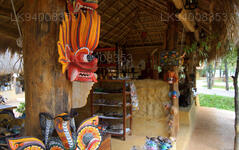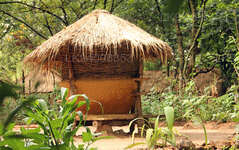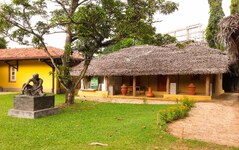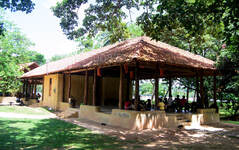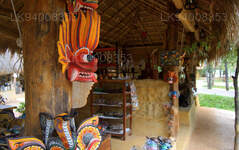
Miasto Kolombo
Kolombo, stolica Sri Lanki, to dynamiczne miasto łączące tradycję z nowoczesnością. Zachwyca kolonialną architekturą, tętniącymi życiem targowiskami i spokojnymi świątyniami buddyjskimi. Z różnorodną kuchnią, rozległą panoramą i pięknymi plażami, stanowi tętniące życiem centrum biznesu, kultury i turystyki, oferując bramę do odkrywania cudów Sri Lanki.
Ape Gama (Our Village; අපේ ගම)
Ape Gama in Sri Lanka: Historical theme Park
Ape Gama in Sri Lanka is a replica of traditional old day Sri Lankan village. This is located in Battaramulla, close to “Diyatha Park”. Ape Gama displays traditional industries, village life style and how self-sufficient old day Sri Lankan society functions in those days.
Formerly, this spot was known as the “Battaramulla Janakala Kendraya” that showcased local crafts. The entire area was revamped for the Commonwealth Heads of Government Meeting (CHOGM) in 2013 to exhibit the fascinating aspects of historic Sri Lankan village life, complete with a bird-watching zone and a mini zoo.
The outstanding recreation of life in a Sri Lankan village has been achieved with precision and attention to detail. It’s not too far from Colombo, situated at the Jana Kala Kendraya in Battaramulla. From the well kempt garden to the many houses made of mud enclosed with wattles, to the figurines of men and women in many postures, the concept has been brought to fruition with much meticulousness. The simplicity and plainness that typifies village living is showcased in all the exhibits.
“Ape Gama in Sri Lanka” attracts throngs of visitors each week seeking a short break in a unique venue.
Ape Gama in Sri Lanka: Village life
Ape Gama is open 365 days of the year from 9 am to 9 pm. And its folk are standing by to explain the many facets of village life. Yes, there are people living in this ‘model’ village attending to everyday tasks for visitors to observe. Karunarathne Mahagamarala is the Headman of this village.
Ape Gama has been constructed as a replica of the old village in Sri Lanka. All the houses are built in a circular form with a ‘meda midula’ or garden at the centre. This is where children used to gather for play while the village was protected along its periphery by the houses. Women folk of Ape Gama are quite busy making and selling Sri Lankan sweetmeats.
A cooking demonstration of sorts take place as women keep themselves busy frying sweets in one pan while sugar and grated coconut is being cooked in another. The demand for these fresh sweets is quite high and the small village ‘boutique’ is finding it difficult to cope with the swelling customers. Women are walking hurriedly to and fro taking the prepared sweets for sale. Visitors finish it off with a cup of herbal drink served in coconut shells. In the meantime the drummer is making music and song seated in the porch of his house.
The houses are separated by fences made of twigs and in some places a narrow bridge made with the trunk of a coconut tree leads to the garden. Varieties of vegetables are grown along the fences. The village is surrounded by trees and tall grass; in one corner of the village is a tree house from where the farmer protects his crops at night.
Ape Gama in Sri Lanka: Arts and Crafts
Beyond Ape Gama is an extension of ‘Sri Lankness’ with many craft houses selling products typically Sri Lankan. The concept is based on creating open spaces just like Ape Gama. Craftsmen work in their outlets making jewellery, carving masks and statues, painting fabric, sewing, making lace and more.
Some of these have been in existence as cottage industries for years and survived for generations. The difference today may be the use of technology and technique, but the elegance remains unchanged. The visitor must take time to go through these craft houses as there is so much to take in.
Ape Gama in Sri Lanka: Visitor Reviews
"It is a very good place for 5th grade school children and for foreigners those who love to see and experience the traditional Sri Lankan lifestyle. The Village Man will explain about the lifestyle and ancient Sinhala vocabulary by giving examples in an interesting manner. Can be experience live clay pot making, wood carving techniques, handmade items along with the..." – Visited January 2017
"Within the park there is Ape Gama a representation of how Sri Lankan villages used to look and operate. There are some classic buildings showing the skill of previous generations in building shelters from the environment. The village is well laid out and easy to stroll around." – Visited April 2016
"Nice paths and scenery to walk around on a nice day. Paths are surrounded by pools of water which look almost natural. Large and small fish can be seen in the water surrounding the paths, but there is a small range of Aquariums nearby filled with several fish. In addition to the small shops (which do not force you to buy stuff) selling plants and aquarium fish, there is also a food stall with a selection of different food to eat."
O dystrykcie Kolombo
Kolombo to największe miasto i stolica handlowa Sri Lanki. Położone jest na zachodnim wybrzeżu wyspy, w sąsiedztwie Sri Jayewardenepura Kotte, stolicy Sri Lanki. Kolombo to tętniące życiem i pełne życia miasto, łączące w sobie nowoczesny styl życia z kolonialnymi budynkami i ruinami. Liczba mieszkańców wynosi 647 100. Region Metropolitalny Kolombo, definiowany przez dystrykty Kolombo, Gampaha i Kalutara, liczy około 5 648 000 mieszkańców i zajmuje powierzchnię 3694,20 km². Kolombo to miasto wieloetniczne i wielokulturowe. Jest to najludniejsze miasto na Sri Lance, z 642 163 mieszkańcami mieszkającymi w granicach miasta. Populacja Kolombo to mieszanka licznych grup etnicznych, głównie Syngalezów, Maurów i Tamilów. W mieście mieszkają również niewielkie społeczności osób pochodzenia chińskiego, portugalskiego, holenderskiego, malajskiego i indyjskiego, a także liczni europejscy emigranci. Zdecydowana większość lankijskich korporacji ma swoje siedziby w Kolombo. Wśród branż znajdują się m.in. przemysł chemiczny, tekstylny, szklarski, cementowy, skórzany, meblarski i jubilerski. W centrum miasta znajduje się drugi co do wysokości budynek w Azji Południowej – World Trade Center.
O dystrykcie Kolombo
Prowincja Zachodnia jest najgęściej zaludnioną prowincją Sri Lanki. Znajduje się tu stolica parlamentarna Sri Dźajawardanapura Kotte, a także Kolombo, centrum administracyjne i biznesowe kraju. Prowincja Zachodnia dzieli się na trzy główne dystrykty: Kolombo (642 km²), Gampaha (1386,6 km²) i Kalutara (1606 km²). Jako centrum gospodarcze Sri Lanki, w mieście obecne są wszystkie główne lokalne i międzynarodowe korporacje, a także wszyscy najwięksi projektanci i detaliści, dlatego warto przygotować się na zakupy w prowincji Zachodniej. Z uwagi na największą liczbę ludności w całej prowincji, w prowincji Zachodniej znajdują się niemal wszystkie najważniejsze instytucje edukacyjne na wyspie. Do uniwersytetów w prowincji zaliczają się: Uniwersytet Kolombo, Uniwersytet Sri Jayewardenepura, Uniwersytet Kelaniya, Otwarty Uniwersytet Sri Lanki, Uniwersytet Buddyjski i Palijski Sri Lanki, Uniwersytet Obrony Generała Sir Johna Kotelawali i Uniwersytet Moratuwa. W prowincji zachodniej znajduje się najwięcej szkół w kraju, w tym szkoły państwowe, prowincjonalne, prywatne i międzynarodowe.

